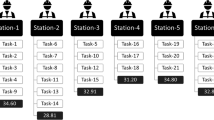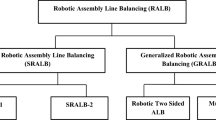Abstract
This paper aims to study tasks’ allocation problem in a single-station collaborative robot assembly system 4.0. Two products with identical demands are run in a system simultaneously in mixed mode to reduce the idle time and improve the system utilization. The idle time occurs due to balancing difficulties and particularly in this case restrictions in the task vs. robot-worker feasibility matrix. It is not allowed for the resources to assemble a same product simultaneously to avoid any direct contact between resources. Thus, the products are swapped between resources as needed to complete the assembly tasks. Two approaches, a novel mathematical model and the shortest processing time (SPT) rule, are propounded in this study to reduce the cycle and idle times and enhance the production rate of an assembly system. The two proposed methods rely on dividing the timeline of a station into unknown stages with unknown lengths. The performance of the proposed mathematical model and SPT rule are evaluated by two performance measures: the total number of stations and the % average station utilization. The obtained results are compared to the results of the modified COMSOAL heuristic. The findings revealed that the novel mathematical model dominated results. It guaranteed minimizing the cycle time and maximizing the production rate compared to the SPT rule and modified COMSOAL heuristic. However, many companies value a 1-s reduction in cycle time as valuable. This directly relates to the reduction of direct resources costs and the total number of stations.










Similar content being viewed by others
Availability of data
Not applicable.
Code availability
Not applicable.
References
Hwang RK, Katayama H, Gen M (2008) U-shaped assembly line balancing problem with genetic algorithm. Int J Prod Res 46(16):4637–4649
Zhang W, Xu W, Gen M (2014) Hybrid multiobjective evolutionary algorithm for assembly line balancing problem with stochastic processing time. Procedia Comput Sci 36:587–592
Bratcu AI, Dolgui A (2003) Synergy, collaboration and self-balancing in production systems-the Bucket brigades. IFAC Proc Vol 36(23):61–66
Salveson M (1955) The assembly line balancing problem. J Ind Eng 6(3):18–25
Zhang W, Lin L, Gen M (2008) Using multi-objective genetic algorithm with fuzzy logic controller for assembly line balancing problem with worker allocation. Int J Inf Syst Logist Manag 3(2):79–88
Boysen N, Fliedner M, Scholl A (2007) A classification of assembly line balancing problems. Eur J Oper Res 183(2):674–693
Öztürk C, Tunalı S, Hnich B, Örnek A (2013) Balancing and scheduling of flexible mixed model assembly lines with parallel stations. Int J Adv Manuf Technol 67(9–12):2577–2591
Hackman ST, Magazine MJ, Wee TS (1989) Fast, effective algorithms for simple assembly line balancing problems. Oper Res 37(6):916–924
Gen M, Tsujimura Y, Li Y (1996) Fuzzy assembly line balancing using genetic algorithms. Comput Ind Eng 31(3–4):631–634
Bautista J, Pereira J (2009) A dynamic programming based heuristic for the assembly line balancing problem. Eur J Oper Res 194(3):787–794
Baker KR (1974) Introduction to sequencing and scheduling. John Wiley & Sons
Özcan U, Toklu B (2009) A new hybrid improvement heuristic approach to simple straight and U-type assembly line balancing problems. J Intell Manuf 20(1):123
Bortolini M, Ferrari E, Gamberi M, Pilati F, Faccio M (2017) Assembly system design in the Industry 4.0 era: a general framework. IFAC-PapersOnLine 50(1):5700–5705
Casalino A, Zanchettin AM, Piroddi L, Rocco P (2019) Optimal scheduling of human-robot collaborative assembly operations with time petri nets. IEEE Trans Autom Sci Eng
Faccio M, Minto R, Rosati G, Bottin M (2019) The influence of the product characteristics on human-robot collaboration: a model for the performance of collaborative robotic assembly. Int J Adv Manuf Technol 1–15
Bogner K, Pferschy U, Unterberger R, Zeiner H (2018) Optimised scheduling in human–robot collaboration–a use case in the assembly of printed circuit boards. Int J Prod Res 56(16):5522–5540
Weckenborg C, Kieckhäfer K, Müller C, Grunewald M, Spengler TS (2019) Balancing of assembly lines with collaborative robots. Bus Res 1–40
Fryman J, Matthias B (2012) Safety of industrial robots: from conventional to collaborative applications. In: ROBOTIK 2012; 7th German Conference on Robotics. VDE, pp 1–5
Wang W, Bandaru S, Sánchez De Ocãna Torroba A (2019) Improved human-robot collaboration through simulation-based optimization. In: Advances in Manufacturing Technology XXXIII. IOS Press, pp 153–158
Suer GA, Almasarwah N, Pagan J, You Y (2021) Assembly system 4.0: human-robot collaboration in assembly operations. In: IFIP International Conference on Advances in Production Management Systems. Springer, Cham, pp 551–560
Gullander P, Davidsson A, Dencker K, Fasth Å, Fässberg T, Harlin U, Stahre J (2011) Towards a production complexity model that supports operation, re-balancing and man-hour planning. In: Proceedings of the 4th Swedish Production Symposium (SPS): Lund, Sweden
Hu SJ, Zhu X, Wang H, Koren Y (2008) Product variety and manufacturing complexity in assembly systems and supply chains. CIRP Ann 57(1):45–48
Mattsson S, Gullander P, Davidsson A (2011) Method for measuring production complexity. Int Manuf Conf
Author information
Authors and Affiliations
Contributions
N.A.: conceptualization, methodology, writing—original draft preparation; G.S.: supervision, methodology; E.A.: writing—review and editing; J.P. and Y.Y.: supervision.
Corresponding author
Ethics declarations
Ethics approval
This paper is new. Neither the entire paper nor any part of its content has been published or has been accepted elsewhere. It is not being submitted to any other journal as well.
Consent to participate
Not applicable.
Consent for publication
Not applicable.
Conflict of interest
The authors declare no competing interests.
Additional information
Publisher's note
Springer Nature remains neutral with regard to jurisdictional claims in published maps and institutional affiliations.
Rights and permissions
Springer Nature or its licensor holds exclusive rights to this article under a publishing agreement with the author(s) or other rightsholder(s); author self-archiving of the accepted manuscript version of this article is solely governed by the terms of such publishing agreement and applicable law.
About this article
Cite this article
Almasarwah, N., Abdelall, E., Suer, G.A. et al. Collaborative robots’ assembly system in the manufacturing area, assembly system 4.0. Int J Adv Manuf Technol 122, 1069–1081 (2022). https://doi.org/10.1007/s00170-022-09932-4
Received:
Accepted:
Published:
Issue Date:
DOI: https://doi.org/10.1007/s00170-022-09932-4




